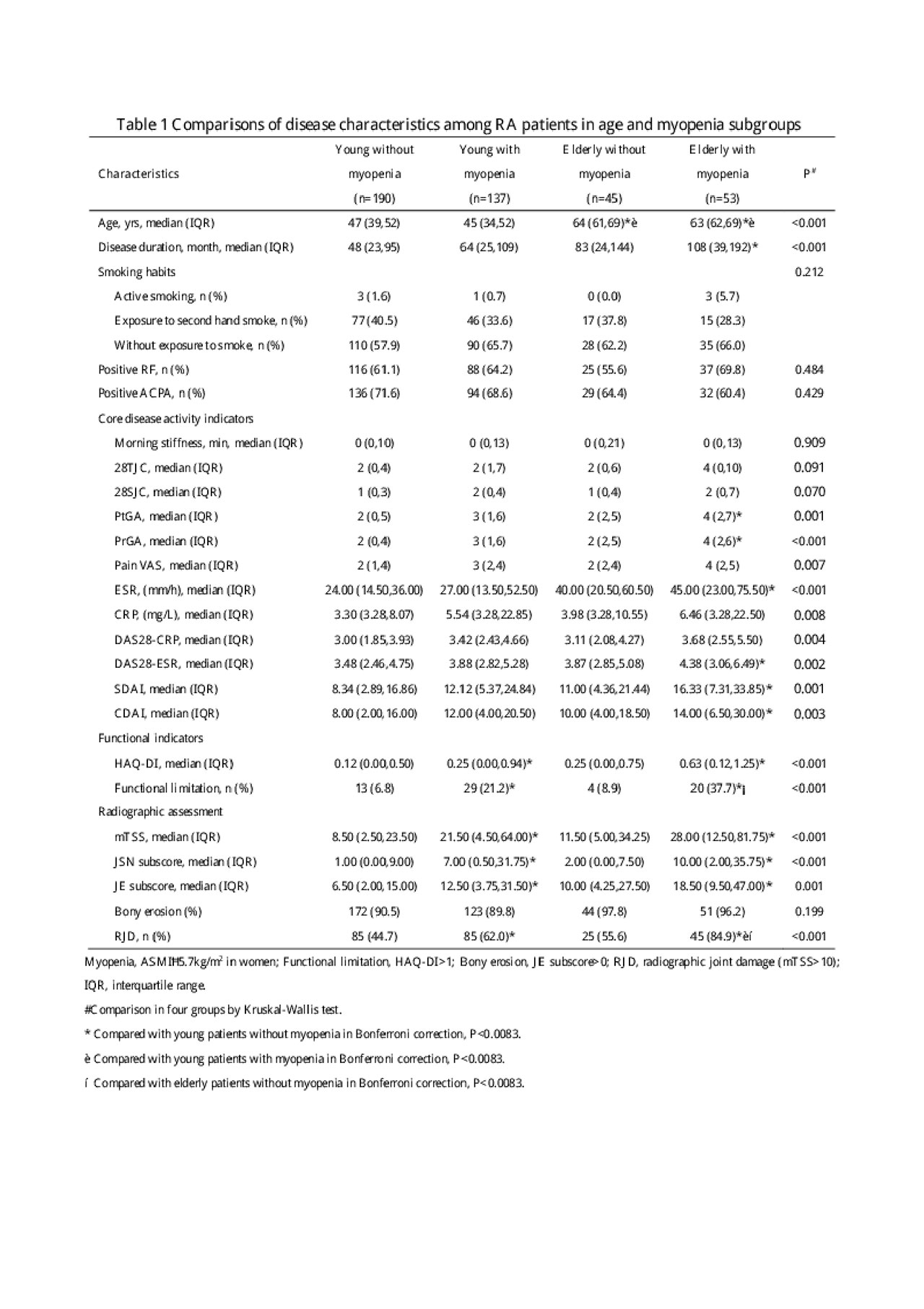Session Information
Date: Sunday, November 10, 2019
Title: RA – Diagnosis, Manifestations, & Outcomes Poster I: Risk Factors, Predictors, & Prognosis
Session Type: Poster Session (Sunday)
Session Time: 9:00AM-11:00AM
Background/Purpose: Our previous study reported myopenia is associated with joint damage in rheumatoid arthritis (RA). However, little is known about body composition (BC) disorder in elderly patients with RA. Here we aimed to explore the characteristics of BC in elderly RA patients and their clinical significance.
Methods: Consecutive female patients with RA who fulfilled the 1987 revised criteria of ACR or 2010 ACR/EULAR classification criteria for RA were recruited from August 2015 to March 2018. Clinical data including disease activity, function and radiographic assessment were collected. BC was assessed by bioelectric impedance analysis. Overfat was defined by body fat percentage (BF%) as ≥35% in women. Myopenia was defined by appendicular skeletal muscle mass index (ASMI) ≤5.7kg/m2 in women.
Results: ①There were 425 female RA patients recruited with median age 50 (IQR 40, 58) years, median disease duration 60 (IQR 24, 120) months. There were 65.6% patients with active RA (DAS28-CRP≥2.6), 15.5% patients with functional limitation (HAQ-DI >1) and 56.5% with radiographic joint damage (RJD, mTSS >10). ②There were 23.1% elderly RA patients (age ≥60 years). Compared with young patients (age < 60 years), elderly RA patients had longer disease duration (median 92 months vs. 50 months), higher ESR (43 mm/h vs. 26mm/h), higher rate of functional limitation (24.5% vs. 12.8%) and RJD (67.2% vs. 51.0%), and higher rate of overfat (49.0% vs. 28.7%) and myopenia (54.1% vs. 41.9%, all P< 0.05). ③Compared with RA patients without myopenia, RA patients with myopenia (44.7%) had longer disease duration (median 72 months vs. 48 months), higher DAS28-CRP (median 3.48 vs. 3.02), higher rate of functional limitation (25.8% vs. 7.2%) and RJD (68.4% vs. 46.8%, all P< 0.05). ④There were 44.7% young patients without myopenia, 32.2% young patients with myopenia, 10.6% elderly patients without myopenia, and 12.5% elderly patients with myopenia. Elderly patients with myopenia had the highest rate of RJD (84.9%) in comparison with other three subgroups respectively. They also had higher rate of functional limitation (37.7%) when compared with young patients without myopenia as well as elderly patients without myopenia subgroups respectively (Table 1, all P< 0.0083, Bonferroni correction). ⑤After adjustment for confounding factors including age, smoking habits, disease duration, RF and ACPA status, multivariate logistic regression analysis showed that both young and elderly patients with myopenia had higher probabilities accompanied by functional limitation (young patients with myopenia: OR=3.479, 95%CI: 1.713~7.063; elderly patients with myopenia: OR=5.727, 95%CI: 2.467~13.292) and RJD (young patients with myopenia: OR=1.896, 95%CI: 1.171~3.068; elderly patients with myopenia: OR=4.627, 95%CI: 1.946~10.999) when compared with young patients without myopenia. Moreover, significant additive interaction was observed between the elderly and myopenia in RJD (AP=0.554, 95%CI: 0.125~0.983).
Conclusion: Elderly female patients with myopenia is associated with severe joint damage in rheumatoid arthritis and the underlying mechanism is worth further study.

Comparisons of disease characteristics among RA patients in age and myopenia subgroups
To cite this abstract in AMA style:
Chen C, Lin J, Ma J, Yang L, Li Q, Chen L, Mo Y, Dai L. Myopenia in Elderly Female Patients with Rheumatoid Arthritis Is Associated with Severe Joint Damage: A Cross-sectional Study [abstract]. Arthritis Rheumatol. 2019; 71 (suppl 10). https://acrabstracts.org/abstract/myopenia-in-elderly-female-patients-with-rheumatoid-arthritis-is-associated-with-severe-joint-damage-a-cross-sectional-study/. Accessed .« Back to 2019 ACR/ARP Annual Meeting
ACR Meeting Abstracts - https://acrabstracts.org/abstract/myopenia-in-elderly-female-patients-with-rheumatoid-arthritis-is-associated-with-severe-joint-damage-a-cross-sectional-study/
